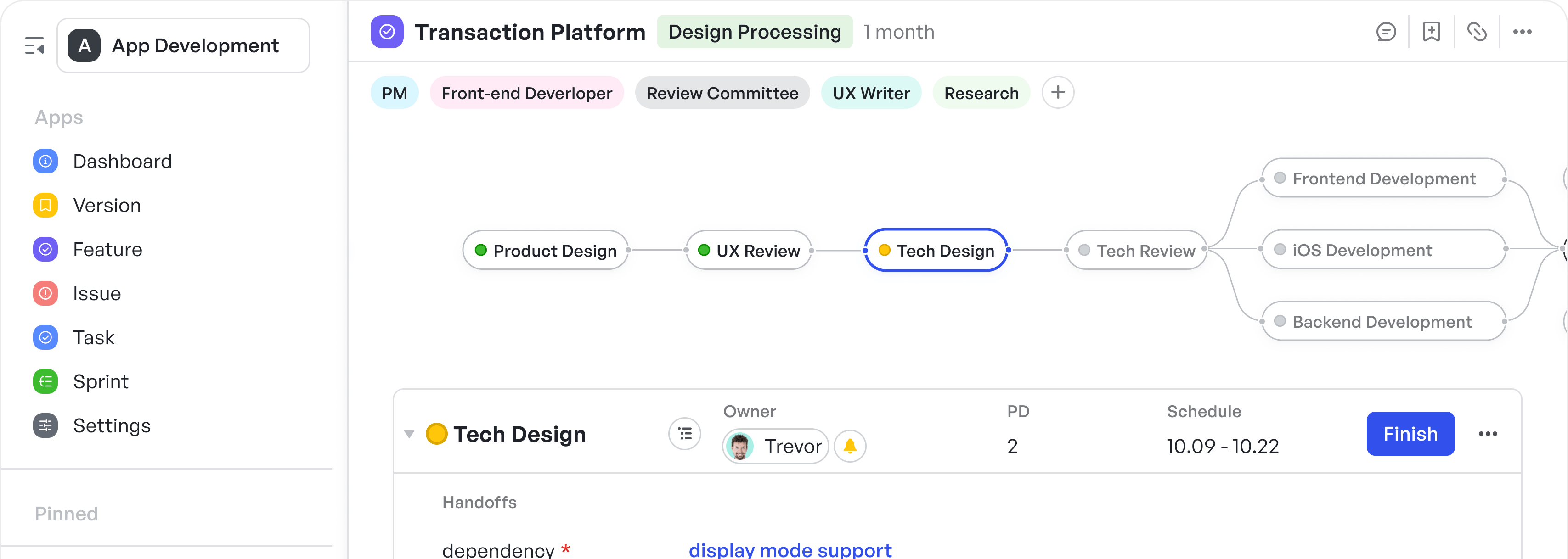As a SaaS project manager, the sheer volume of tasks to track is bound to leave you overwhelmed.
You're not alone. Effective progress reports can turn this challenge into a streamlined process that keeps your team aligned. These reports also help anticipate and address potential bottlenecks before they impact your project's success.
If every status report generated could give you relevant data along with actionable insights, you can make informed decisions quickly and keep your project agile and responsive to change. This is what effective project status reports do — they help you manage projects more efficiently while significantly reducing the time spent on manual updates.
But does project status report creation have to be a manual ordeal? Can it be automated to save you and all the relevant stakeholders valuable time?
The answer is yes: status report creation can be automated. This comprehensive guide will show you how to automatically create impactful status reports that are instrumental in driving your project forward successfully.
What is a status report?
A status report is a snapshot of a project’s progress against its planned objectives and timelines. Its purpose is to keep all stakeholders informed on the project’s current state, any shifts in direction, and upcoming priorities.
An effective status report offers updates that set the stage for proactive decision-making. Timely insights on project progress, milestones, and potential risks allow stakeholders to anticipate challenges, adjust expectations, and make informed decisions to keep the project on course.
250px|700px|reset
加载中,请稍后
Status reports usually include:
- A summary of the project’s current state
- An update on milestones and deliverables
- Any changes to the project scope or schedule
- Identification of any risks or issues, along with proposed or implemented solutions
- An overview of tasks completed and tasks that are pending
This kind of visibility is crucial in SaaS environments where many cross-functional teams are involved. A status report serves as both a checkpoint and a guide — centralizing data from different teams and aligning individual team efforts with the project’s goals.
How project reporting keeps your SaaS project on track
Every SaaS brand is like an efficient industrial process. You can release new features, versions, and make changes to the software’s functionality in a timely manner only if the individual teams work on the relevant tasks and move it down the execution line.
Below is a typical SaaS roadmap that demonstrates how different teams contribute to bringing a feature from idea to feature release.
250px|700px|reset
加载中,请稍后
Project roadmap journey for a software product
Project reporting brings these inter-connected dependencies together to add structure, visibility and foresight. An efficient process ensures a smooth flow. On the contrary, an error from one team can cascade into the whole roadmap, causing delays and modifications.
Managing dependencies can save time; however, treating them as a strategic requirement can have a bigger impact on the success of a project. Here’s how project status reports benefit the project's health:
Monitor project health
Status reports include assigned tasks, execution timelines, progress against key metrics and potential issues. All this data gives a real-time view of the project’s health, allowing teams to stay aligned with the project’s goals.
Summarize key milestones and deliverables for alignment
Project reports summarize completed and upcoming milestones so that every stakeholder understands what has been achieved and what’s coming up. This shared understanding helps align team efforts, thus reducing the risk of misalignment or duplicated work.
Reduce manual work and streamline meetings
Centralized data in status dashboards allows team members and stakeholders to access updates anytime, reducing the need for frequent check-in meetings. Automated updates and visual data make reporting more efficient, freeing up time and cutting down on manual tasks.
Clarify next steps and assign action items
A well-structured status report outlines the next steps, detailing tasks and action items for each team. This clarity ensures everyone is aligned with priorities and responsibilities, which is crucial for dynamic SaaS projects.
Identify risks and roadblocks before they escalate
Status reports that highlight potential blockers and risks allow teams to address challenges proactively. By anticipating issues, stakeholders can implement risk management and mitigation strategies to keep the project timeline intact.
Automated, accurate and consistent communication is the strongest weapon in a project manager’s arsenal. It can build a transparent environment where all stakeholders stay informed and engaged.
This proactive, structured approach keeps every stakeholder aligned, empowering teams to make quick, data-driven decisions that lead to successful outcomes.
Types of project status reports
Now that we have discussed how project reports offer a structured approach, it is important to note that the frequency and scope of project status meetings and reports can vary depending on the teams involved and the project phase.
Choosing the right type of report assures that stakeholders receive timely, relevant updates without information overload. Here are the main types of project status reports and when to use them:
Daily status reports
Daily status reports offer a granular view of progress, which is ideal for fast-paced projects or critical stages where frequent updates are necessary. It typically includes a brief update on the day’s tasks, any immediate blockers, and action items for the following day.
✅Best for: Agile sprints, end-stage testing, or any phase requiring rapid feedback and adjustment.
Weekly status reports
Weekly status reports provide a broader view, capturing progress and challenges across the week. They cover key achievements, upcoming tasks, and any risks that could impact future projects or the timeline, making them useful for ongoing project progress reports.
✅Best for: Regular team updates, stakeholder check-ins, and tracking week-over-week progress on project milestones.
Monthly status reports
Monthly reports are high-level summaries that capture major milestones, shifts in the project schedule and scope, and overall project health. These reports are particularly useful for stakeholders who don’t require daily or weekly updates but need to stay informed about the project’s direction.
✅Best for: Executive-level updates, long-term projects, and phases where significant progress or adjustments occur over longer time frames.
Quarterly status reports
A quarterly project summary report provides an overview of the project’s progress over a three-month reporting period. This type of progress report focuses mostly on long-term goals, key performance indicators (KPIs), and any strategic adjustments. These reports are useful for aligning the project’s direction with broader organizational goals.
✅Best for: Strategic planning sessions, large-scale projects, and quarterly business reviews with senior stakeholders.
Each type of status report serves a distinct purpose and audience, guaranteeing that all stakeholders receive the information they need at the right time.
By using a mix of daily, weekly, monthly, and quarterly reports, you can maintain transparency and keep the project progressing as planned without overwhelming your team or stakeholders.
Key elements of a status report
In complex SaaS organizations, the challenge often lies in pulling together the most relevant information from multiple projects and teams, presenting it in a clear and concise way, and ensuring it addresses the needs of various stakeholders.
The process can feel overwhelming, especially in projects where timelines are tight, and priorities shift quickly.
An effective status report should cut through the noise and provide a focused, actionable view of the project’s health. Below are the essential elements that can turn a good status report into a practical tool that helps keep your project on course:
Summary of current project status
Provide a concise, high-level overview of the project's current status, including the project name, overall health (on track, at risk, or behind schedule), and notable recent developments. The summary gives stakeholders a quick snapshot without requiring a detailed analysis of interconnected data points.
Milestones and deliverables
Status updates on project plan and project deliverables keep every team informed and aligned on what’s been achieved, and what’s due next. This element is critical for maintaining momentum, especially in complex projects with multiple teams and moving parts.
Changes to scope or schedule
Document any adjustments to the project’s timeline or scope, along with the reasons behind them. Recording these changes prevents misunderstandings and helps stakeholders adjust their expectations as the project evolves.
Identified risks and mitigation plans
Proactively identifying risks and outlining mitigation strategies help the team avoid potential setbacks. Clearly document any known risks, their impact, and the steps being taken to address them to keep everyone informed and ready to pivot if needed.
Completed and pending tasks
Summarizing recent accomplishments and tasks in a progress report gives stakeholders a clear sense of what has been done and what’s left to do. Listing pending and upcoming tasks sets expectations for future tasks.
Next steps and action items
Outline the next steps, assign team members and deadlines, so everyone knows their responsibilities moving forward. It reinforces accountability and keeps the entire project staying on course.
7 actionable steps to writing an effective project status report
7 actionable steps to writing an effective project status report
250px|700px|reset
加载中,请稍后
Collating all data points, reviewing progress, and creating a status report comes with its fair share of questions.
What information is essential?
How do I keep it concise but impactful?
How can I ensure it’s clear for every stakeholder, from executives to team members?
Treading the fine line between information and information dump is as taxing as it can get.
Here’s a step-by-step guide to writing a status report that communicates effectively drives action, and keeps your project on schedule:
Identify the report’s objective
Start by zeroing in on the primary purpose of the report.
Are you updating stakeholders on overall project health, tracking specific milestones, or addressing recent challenges to the project budget? Defining the objective will guide the structure and content of the report, assuring it’s focused and relevant.
Know your audience and tailor content
Tailor the report based on who will read it.
Executives may need high-level summaries and strategic insights, while team members and department heads may need more detailed task updates and timelines. Adjust the language, detail level and focus accordingly.
Simplify data gathering by prioritizing key updates
Collect accurate data from all relevant sources—whether that’s a project management tool, a development team’s sprint board, or feedback from user testing.
Prioritize information that aligns with the report’s objective, ensuring your report stays concise yet comprehensive.
Organize the report for readability
Structure the report in a logical flow that makes information easy to follow.
Use headers, bullet points, and sections to break up content, and cross-check to see if each section flows naturally into the next. For digital reports, consider adding navigation links for quick access to specific sections.
Convert information into actionable insights
Summarize the most important information upfront—whether that’s the project’s current health, major achievements, or critical blockers.
Then, clearly outline the next steps and action items to keep the project moving forward, assigning responsibility where applicable.
Use visuals for better understanding
Use charts, graphs, or progress bars to represent data visually.
Visuals can help convey complex information quickly, making it easier for stakeholders to grasp key metrics at a glance. Ensure visuals are clear, relevant, and support the report’s key data points.
Edit for precision and brevity
Review your report to verify it’s free from jargon, unnecessary detail, and potential misinterpretations. Aim for straightforward language and a concise format, so your report is easy to read and actionable.
Distribute the report through an agreed-upon channel, whether that’s a project management platform, email, or during a status meeting. Be prepared to answer questions or clarify details as needed, ensuring that the report is a springboard for productive discussions.
With a structured approach, each report you produce meets its objective and keeps your project stakeholders aligned and engaged.
How to use templates effectively to simplify status reporting
The first step in creating a structured approach is to use a project status report template. It significantly streamlines report creation by providing a predefined structure, which saves time and establishes consistency.
Here are some practical ways to get the most out of templates, along with situations where each type of status report template shines:
- Standardize your reporting: Consistent use of templates creates a reporting structure that stakeholders recognize, making it easier for them to interpret updates without extra explanation.
- Save time with automation: Many project management tools allow you to automate data entry within templates. Set up automated fields for recurring metrics so each report includes up-to-date information without requiring manual updates.
- Customize as needed: Each project has unique needs, so don’t be afraid to adapt templates. Start with a basic structure, then add or remove sections to match your audience or project requirements.
Situational template recommendations for status reports
Not all templates fit every situation, and that’s okay. Here are some tailored templates designed to simplify status reporting and make life easier:
Issue resolution for business operations
250px|700px|reset
加载中,请稍后
Meegle’s issue resolution template
This works as your already laid down pipeline from problem to escalations, and solution. Meegle’s resolution template for instance, keeps everything on track by clearly documenting the issue, tracking progress, and flagging blockers.
For business operations, it’s a lifesaver when you're juggling recurring issues or urgent fixes. By mapping out the resolution steps in a status report, you cut through noise and drive decisions faster.
HR onboarding
250px|700px|reset
加载中,请稍后
Meegle HR onboarding template
Status reports for onboarding? Yes, seriously. For example, Meegle’s onboarding template automate updates: when HR finishes "Pre-Onboarding," automation kicks in, notifying new hires about their next steps.
By the time the one-month review hits, the manager has a clear picture of progress and feedback, making status updates seamless and actionable.
EDM Marketing
250px|700px|reset
加载中,请稍后
Meegle Electronic Direct Mail Marketing Template
A good status report captures the lifecycle of your marketing campaign, from concept to performance review. Meegle’s template for EDM allow you to include metrics directly in the report: total sends, opens, clicks, and even user engagement trends.
The status updates recorded from these metrics double as a playbook for future campaigns, simplifying decision-making and better streamline processes next time around.
Agile sprints
250px|700px|reset
加载中,请稍后
Meegle’s Agile template
Agile projects benefit from a sprint status template, which focuses on sprint goals, completed tasks, and blockers encountered. This format supports the fast-paced, iterative nature of Agile work.
In this context, Meegle’s agile development template has a centralized method to manage Epics, Stories, Sprints, and Tasks directly streamlines status reporting by making all relevant data accessible in one place.
So, instead of chasing updates from different team members or cross-referencing tools, you can pull key details like task completion percentages, sprint progress, or upcoming milestones directly from the template. This eliminates time-consuming manual compilation and reassures the accuracy of your report.
When you choose and adapt templates specific to project needs, you can create reports that are easier to compile and impactful for your team and stakeholders.
How Meegle helps with status reports
Meegle, a user-friendly and intuitive project management software, enhances the status reporting process through its real-time tracking, intuitive visual workflows, and centralized data approach. Here’s how Meegle empowers the entire project team to work more effectively:
Real-time tracking for up-to-date insights
Real-time tracking for up-to-date insights
250px|700px|reset
加载中,请稍后
Track the state and ongoing status of designated phases within each stage of the product development journey
Development teams often find it difficult to update stakeholders on sprint progress and manage iteration cycles.
Meegle’s and automated updates enable the project team to share timely updates without manual intervention, making sure everyone has accurate, up-to-date insights into each sprint’s status.
With real-time visibility into sprint progress, a project manager can generate a project status report that highlights completed tasks, active sprints, and potential blockers, helping stakeholders stay aligned without needing frequent check-ins.
Visual workflows for clear communication
Visual workflows make it easy for teams to communicate the project’s current status at a glance, boosting transparency and alignment.
Meegle’s visual workflows simplify the presentation of complex data, transforming status updates into intuitive visuals. It enhances stakeholder engagement by clearly conveying project status updates, task progress, and potential risks.
Using Gantt charts and Kanban boards, you can create a project status report that showcases project milestones, completed tasks, and upcoming priorities, allowing every team member to quickly understand the project trajectory.
Advanced charts
Meegle’s charts function takes project status reporting to the next level. Tools like the cumulative flow diagram provide a snapshot of workflow efficiency by displaying task status, allowing teams to spot bottlenecks early and address them proactively.
250px|700px|reset
加载中,请稍后
Flow diagram showing task status to better visualize and control project timelines
Real-time reporting to identify patterns & spot trends
The reporting feature in Meegle significantly cuts down on the time required for report generation by pulling data from multiple sources and consolidating it seamlessly. Insights such as staff efficiency, workload distribution, subtask density, feature distribution, etc. help managers tally the project's scope, budget status, and take strategic decisions.
Simply set up triggers, conditions, and operations, so that tasks can be pushed forward automatically. Because of this automation, teams can focus on critical tasks instead of getting bogged down in administrative work, ensuring that status reports are both comprehensive and time-saving.
With automated status reports, a project manager can generate a weekly status report with project details that includes all essential updates, such as task completion and milestone tracking, freeing up time for strategic project planning.
Collaboration tools for team alignment
250px|700px|reset
加载中,请稍后
Creating team batches for better collaboration and communication
With Meegle’s collaboration tools, businesses can foster real-time communication among team members.
Teams can work together to update the project status report, sharing feedback and adjusting timelines collaboratively. With a centralized approach, everyone remains on the same page throughout the reporting period.
Centralized data for comprehensive insights
Meegle centralizes all project data, offering stakeholders a single source of truth. It ensures consistency and accuracy in project status reports, reducing discrepancies and enhancing trust in the project reporting process.
For example, you can generate a monthly status report that pulls data from all relevant tasks and milestones achieved in the previous month, offering stakeholders a complete view of the project’s progress.
Customizable templates for streamlined reporting
Meegle’s customizable project status report templates cater to diverse project requirements, guaranteeing that critical elements are consistently included. Project managers can maintain clarity, professionalism, and relevance in every report with standardized reports. Once a standardized process is set up, status report creation becomes an automated task.
With templates like the EDM Marketing template or Agile Development template, you can tailor status reports based on specific team needs—whether for a marketing campaign or sprint cycle—guaranteeing that each report is actionable and aligned with stakeholder expectations.
Drive campaign success with the EDM marketing template
For marketing teams, reporting on campaign effectiveness is crucial. Meegle’s EDM Marketing Template simplifies this by organizing each phase of the campaign lifecycle, from content creation to performance metrics. You can create detailed, insightful status reports without scouring data points from fragmented sources.
For example, a marketing manager can generate a monthly status report using the EDM Marketing template, tracking metrics like open rates and clicks. It keeps key stakeholders informed on campaign performance and areas of improvement, aligning everyone with campaign outcomes.
Development made simple with Meegle’s agile development template
For development teams, frequent status updates and sprint tracking can be complex. Meegle’s Agile Development Template captures real-time sprint data, helping teams maintain focus on key milestones and share meaningful updates with stakeholders without disrupting the development workflow.
The Agile Development status report template summarizes sprint progress, completed stories, and identifies risks, enhancing transparency and supporting development principles.
Derive actionable insights with Meegle’s charts dashboards and measure function
One of the greatest challenges of creating status reports is making sense of data in a way that drives actionable insights.
Valid, actionable insights among all data points resemble something akin to needles in haystacks.
250px|700px|reset
加载中,请稍后
CRM dashboards with factual visuals to better analyze and spot high-risk areas on projects.
Meegle’s dashboards aggregate project metrics into a single view. By setting up custom metrics on the dashboard, such as engagement KPIs or project milestones, project managers can gain a clear, tailored view that supports faster, data-driven decision-making.
Additionally, Meegle’s Measure function enables managers to define custom formulas for tracking specific KPIs and visualize critical project metrics, all in one place.
Highlight roadblocks with intuitive labels
250px|700px|reset
加载中,请稍后
Labels to keep track and identify status reports and updates on designated tasks
Effective status reporting requires transparency around potential blockers and delays. Meegle’s intuitive labeling system enables project managers to quickly tag any identified issues, making them visible to stakeholders at a glance.
In addition to displaying the exact number of days, teams also have the option to configure automated delay notification messages that guarantee all relevant stakeholders are promptly notified.
By integrating real-time tracking, dynamic project views, custom dashboards, and tailored templates for both marketing and development teams, Meegle equips SaaS project managers with the tools to produce comprehensive, actionable status reports. These features simplify dependency tracking, improve visibility into project progress, and keep all stakeholders aligned—ultimately enhancing project outcomes and reducing reporting overhead.
Wrapping your project up with an executive summary
Executive summaries are concise, high-level overviews of the project’s progress, key achievements attained, and upcoming steps required. It drills complex project details into an easily digestible format for stakeholders, clarifying where the project stands and what’s next.
In Meegle, creating an executive summary is easier with features like the Tree View that organizes project progress hierarchically, presenting a clear global perspective that’s perfect for summarizing milestones.
250px|700px|reset
加载中,请稍后
Meegle’s Tree View
For example, in a product development project, this view breaks down the structure into levels, projects, features, and issues. This makes it pretty much straightforward to see what’s complete, what’s pending, and where the focus needs to shift.
Aggregate fields further enhance this process by automating data consolidation. By combining updates from text fields, Meegle creates a seamless summary of project performance metrics, pending tasks, and quality checks.
Instead of manually compiling information, you can generate a polished, up-to-date executive summary with just a few clicks.
Improve stakeholder engagement through effective status reporting
At the end of the day, week, or month, these status reports provide you, your team, and your bosses with a 360-degree view of the project. They highlight everything that’s going according to plan, but more importantly, they reveal the small gaps and deviations that need attention.
Once you address these gaps, you move one step forward towards completing the project within the predetermined timeline.
What Meegle offers is automation and simplicity. You decide the project parameters such as tasks, people, time, resources, and more, and Meegle manages it for you. It cuts down on the unnecessary to-and-fro emails and messages enquiring about updates, reasons for delays, requests of rescheduling through its centralized and live dashboard.
Whether you want to create and launch a new app or open a restaurant, you and all interested parties/stakeholders can rely on accurate and extensive project status reports to measure success and achieve your goal.
To learn more about how you can improve stakeholder communication with automated project status reports through Meegle, book a free trial today.





